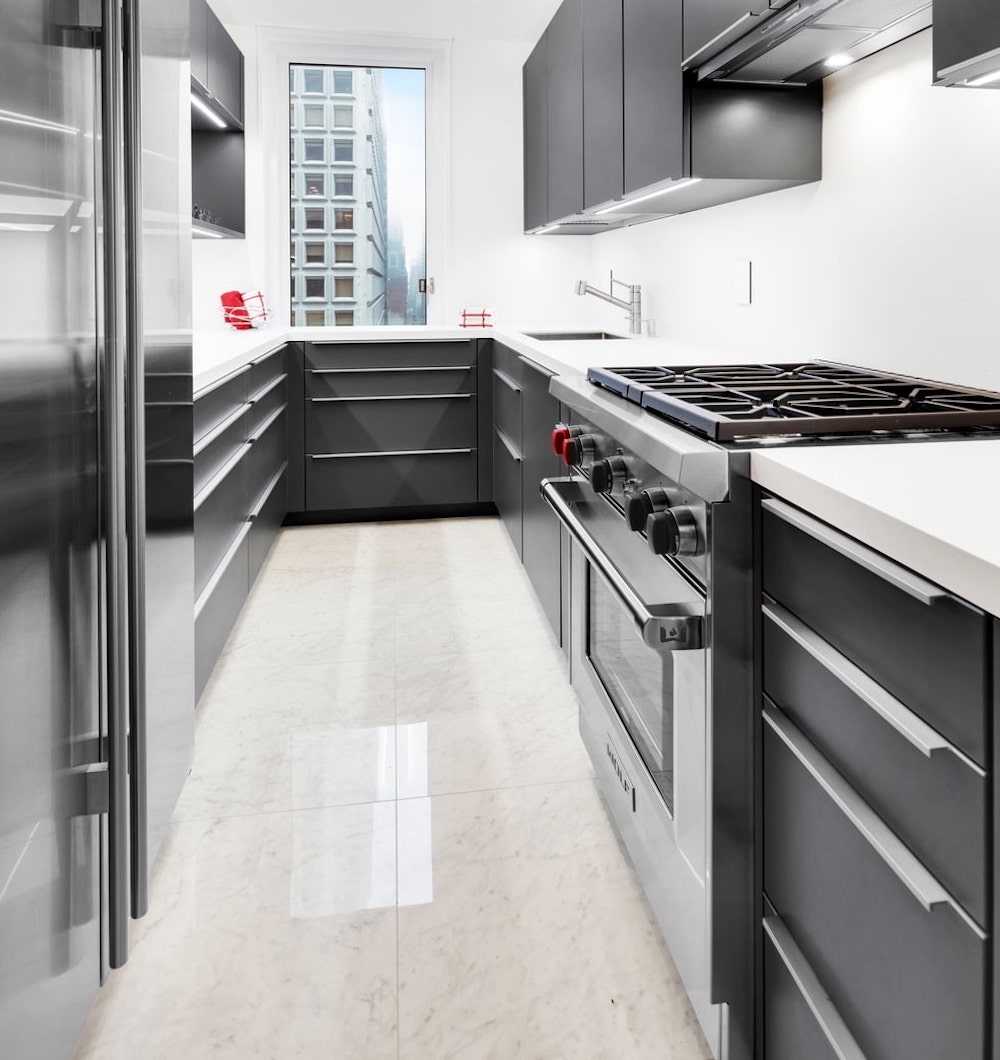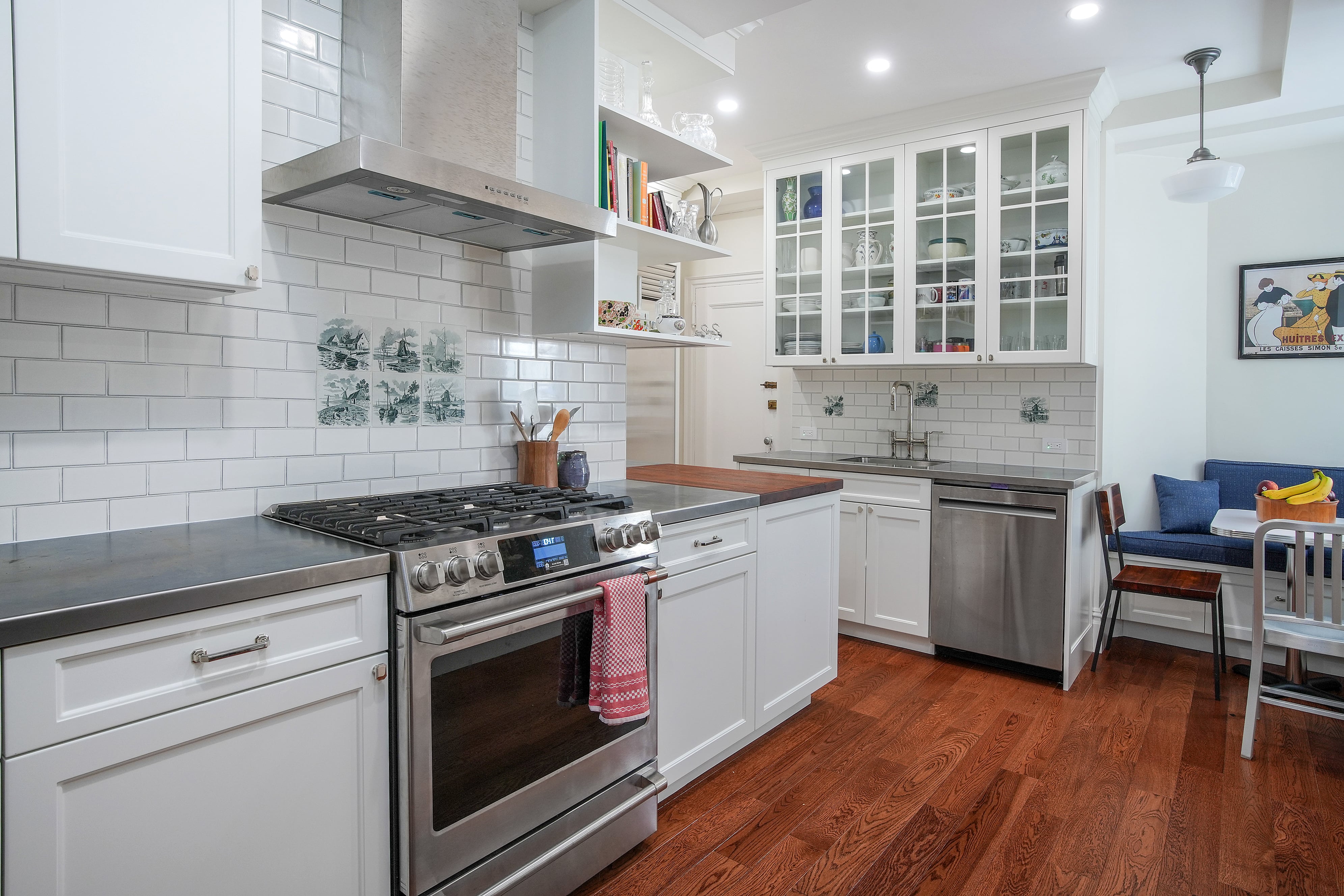What Type Of Flooring is Best For My NYC Renovation?
See why flooring is maybe the most important design factor in any renovation.
October 8, 2024
|

What Type Of Flooring is Best For My NYC Renovation?
Flooring is an important design factor in any renovation, so make sure to consider all factors when choosing your floors.
Table of contents
- Hardwood vs. Engineered Wood: More Than Just Looks
- Selecting Flooring for Different Rooms in Your NYC Home
- Different Flooring Materials for NYC Renovations
- Installation & Design
When planning a renovation in New York City, choosing the right flooring isn’t only about aesthetics. To maximize your home design, you must consider the unique conditions of your building and how different flooring options will perform within that context. Whether you’re deciding between traditional hardwood and engineered wood, or considering the implications of renovating in older buildings, here’s a guide to help you navigate flooring decisions with more than just the basics in mind.
.jpeg)
[#1]Hardwood vs. Engineered Wood: More Than Just Looks[#1]
Many articles outline the general pros and cons of traditional hardwood versus engineered wood. Ultimately, the difference is this - hardwood is timeless and can be refinished multiple times, while engineered wood is more stable in humid conditions and can be more cost-effective. But, there’s more to consider when choosing between the two, especially when dealing with NYC buildings.
Building Type Dictates Your Flooring Choice
When considering flooring options, the age of your building is one of the most crucial factors.
Flooring For Pre-War Buildings
If you live in a pre-war building, your subfloor likely consists of wooden planks with gaps between. If you’re aiming for a herringbone or chevron pattern, traditional hardwood might be the better option. That’s because engineered wood, which is typically thinner, may not hold up as well if the subfloor isn’t perfectly even (rare is pre-wars). These gaps can cause engineered boards to wobble if they land right over them, potentially leading to an uneven floor unless you invest in redoing the subfloor entirely.
In some cases, blending flooring types can be necessary to maintain the building’s historical integrity. For example, during our full renovation of a pre-war co-op at 1035 5th Avenue in Manhattan, we faced the challenge of protecting the distinguished pre-war details. This required not only floor restoration but also careful stitching of new flooring into large sections of the original parquet, ensuring a seamless blend with the historic design.
Flooring For Post-War Buildings
If you’re renovating in a post-war building, especially one constructed between the 1950s and 1970s, there’s a good chance you’ll encounter glued-down parquet flooring that might contain asbestos (Read: Common Surprises When Renovating A NYC Apartment). In these cases, it’s often more cost-effective to install a new floor directly over the existing one. This approach can help you avoid the costly and time-consuming process of asbestos abatement. For this situation, engineered wood is typically the best choice because its thinner profile prevents issues like doors not opening properly, which can happen if the new flooring is too thick.
The Impact of Your Building’s Floor Plan and Layout
Your apartment’s layout significantly influences your flooring choice by determining how the flooring will look and function in different spaces.
Flooring For Open Floor Plans
For instance, if you have an open floor plan and want a uniform look across your space, including the kitchen, you need to consider how different flooring materials interact. Wood and tile transitions can be tricky, and the type of wood you choose could affect the cohesion and flow of your space. For instance, consider the flooring in our NYC condo renovation in Carnegie Hill at 8 East 83rd. While the majority of the open floor plan apartment has herringbone wood flooring, determination was made that having herringbone flooring in the kitchen would have been busy on the eye. Instead, we went with straight planks for the kitchen and blended from the living room with a custom wood flooring design.
Flooring for Multi-Level Apartments Or Townhomes
If you live in a multi-level apartment or townhouse in NYC, the transition between levels presents unique challenges when renovating. Stairs are high-traffic areas, and the material you choose not only needs to match the rest of your home’s aesthetic, it needs to be durable. In these instances, opt for hardwood or engineered wood that can withstand heavy use. For our Manhattan Townhouse Renovation at 529 East 87th, we chose to maintain and refinish the original hardwood floors on the lower level, then update the flooring upstairs with a matching species of 4” white oak.
Accounting For Unique Architectural Features
In pre-war homes, the right flooring can accentuate architectural accents such as exposed brick, original mouldings, or floor to ceiling windows. However, in this regard, color may be more impactful than wood type. For example, a natural dark walnut hardwood can contrast beautifully with the elegance of traditional pre-war mou ldings (EX: Upper West Side pre-war co-op renovation @ 801 West End Ave), while a lighter engineered white oak might enhance the brightness of a large open space with immersive natural light (EX: Condo Renovation Downtown Brooklyn @ 388 Bridge Street).

[#2]Selecting Flooring for Different Rooms in Your NYC Home[#2]
Living Rooms and Common Areas
In NYC apartment renovations, nothing quite matches the timeless appeal and warmth that hardwood or engineered wood floors bring to living rooms and common spaces. With a wide range of finishes, stains and wood grains available, these floors can be customized to perfectly complement any interior style, from sleek and modern to classic and elegant. Beyond aesthetics, hardwood offers incredible longevity, with the ability to be refinished multiple times, ensuring your floors will age beautifully alongside your home.
For families with pets or children, a more durable option like laminate and luxury vinyl may be a preferable alternative to wood grain, as they’re much more resistant to scratches and spills, while still offering a sophisticated look.
Kitchen Flooring
A common sight in kitchens is either the same hardwood/engineered flooring that is continued through the rest of the home OR porcelain; sometimes marble. We typically don't recommend marble in the kitchen because it's a soft stone. If you drop a pot or a knife slips out of your hand, the odds that it will damage the floor are high. Marble must be kept up or it will stain, so it’s a high-maintenance material too.
From a design perspective, if your home has an open floor plan, continuity is the main factor. If you have an island and the kitchen is largely visible from the rest of the space, the best design sense is to continue with the existing floors. In spaces that are less open, such as galley kitchens or ones where the island is a peninsula, the continuity of the hardwood/engineered is less relevant. In those instances, porcelain makes for a great threshold tile. It’s not porous, so it’s much easier to maintain and clean – ideal for the kitchen.
Bathroom Flooring
Bathroom flooring is a conversation entirely its own due to the large variety of stones – a topic for another day. For our purposes, the main factors when choosing bathroom flooring includes both the general interior design aesthetic as well as grout. Clients who don’t want to see all that grout tend to prefer large slabs over smaller tiles.
Marble is a popular luxury tile used in the bathroom, providing a soft, pleasant sensation under the feet. It does require upkeep to prevent staining, but dropped items are much less likely to cause any damage in the bathroom. Other common choices for bathroom floor tiles include porcelain, Dekton, or quartzite.
Bedrooms
Bedroom flooring should offer comfort and warmth, creating a peaceful retreat from your daily stressors. To accommodate that need for a lax lower layer, aim for soft hardwoods like pine or cherry, which are not only on the softer side but add warmth and character to bedroom designs. Furthermore, these rich wood types also have added insulation properties. A more eco-friendly alternative would be cork flooring, which has natural soundproofing characteristics.
Home Offices
As WFH becomes a regularly known acronym and home offices become increasingly essential in NYC apartment renovations, selecting the right flooring can significantly impact both productivity and comfort. For office spaces, laminate and vinyl flooring are excellent choices due to their durability and ease of maintenance. These materials can withstand heavy furniture, rolling chair casters, along with most daily wear and tear, making them ideal for high-traffic areas in home offices. Additionally, for those prioritizing a quiet, focused work environment, good ol’ carpet offers sound-absorbing qualities, helping to reduce noise interference during online meetings and calls, enhancing the overall work from home experience.

[#3]Different Flooring Materials for NYC Renovations[#3]
Solid Hardwood Floors
Solid hardwood comes in a variety of wood species, which are then separated by grade based on level of imperfections. Some common species include oak, cherry, pine, hickory, and walnut, though oak reigns as the most popular overall.
American oak is popular in both white and red, with a larger grain than its European counterparts, which tend to be sourced from France, Germany, and England. European Oak tends to be more durable, with French Oak in particular is a common luxury flooring choice.
Among our clients, the most popular is a 5-inch wide plank select oak, with select referring to the grade.
Pro: Traditional hardwood floors can be sanded down and refinished numerous times during their lifespan.
Con: They are more expensive.
Learn the lingo: There are three grades of wood: Select, #1 Common, and #2 Common. Select is considered top-tier, the highest grade. The main difference as the grade decreases has to do with the color variation; the more variation, the lower the grade. If you’re looking to be smart with your budget and aren’t too worried about color variations, a lower grade is one way to do it.
Engineered Floors
Engineered floors are made of numerous thin layers, but only the top layer is true real hardwood. The other layers are typically composed of wood, polymers, and resin. In a nutshell, that’s the main material difference between the two. The additional pros and cons come into play when we start to talk about actually getting this new flooring installed and ready to be walked upon.
Pro: Engineered wood floors are more resistant to scratches and damage when compared to hardwood, as well as traditionally less expensive.
Con: Because there is only one layer of hardwood, they can only be sanded down once or twice during their lifespan. (Although some can be refinished up to 4 times)
Concrete Flooring
Concrete floors are gaining popularity in modern, minimalist designs, offering a sleek, industrial aesthetic. When polished, concrete has a smooth, reflective finish that can elevate any common area or living room. Concrete can also be stained or stamped to mimic stone or tile patterns, making it highly versatile.
Pro: Concrete flooring is incredibly durable, low-maintenance, and resistant to stains, making it a practical option for high-traffic areas. It also retains heat well, especially when paired with radiant heating systems.
Con: Without proper treatment, concrete can feel cold and hard underfoot, and it may develop cracks over time.
Bamboo Flooring
Bamboo flooring offers an eco-friendly alternative to traditional hardwood. As a fast-growing grass, bamboo regenerates quickly, making it a sustainable choice. Bamboo is available in various styles, such as strand-woven, which increases its strength, or traditional horizontal and vertical grains, which create unique aesthetic options.
Pro: Bamboo is highly renewable and can be as strong as hardwood, particularly strand-woven bamboo, which is more durable and resistant to moisture. It’s also naturally antimicrobial.
Con: While durable, bamboo can be susceptible to scratches, and cheaper varieties may not be as moisture-resistant.
Terrazzo Flooring
Terrazzo flooring is a composite material, traditionally made from chips of marble, granite, glass, or other materials embedded in cement, then polished to a smooth surface. Its mosaic-like appearance brings an artistic flair to living spaces, with a wide range of color and design options.
Pro: Terrazzo is incredibly durable, long-lasting, and easy to maintain. Its smooth surface is resistant to stains and scratches, making it ideal for busy households.
Con: Terrazzo can be costly to install, and the surface may feel cold or hard without underfloor heating.
Reclaimed Wood Flooring
Reclaimed wood flooring repurposes wood from old buildings, barns, or other structures, giving it a second life. This type of flooring is valued for its unique character, with each plank featuring natural wear, knots, and grain patterns that can’t be replicated with new materials.
Pro: Using reclaimed wood is an eco-conscious choice, reducing demand for new lumber while bringing warmth and history to a home. It also has the added benefit of being fully cured, making it less prone to warping.
Con: The sourcing and preparation of reclaimed wood can make it more expensive than other types of flooring, and it may require more care during installation due to its age.

[#4]Installation & Design[#4]
As discussed, the installation method of your flooring typically depends on building type or client preference, while various other factors may play a role in the install direction. Here are a few questions to consider before deciding on your flooring route.
What Is The Right Type Of Sealant - Oil or Polyurethane?
When it comes to sealing unfinished floors, one of the most important decisions is the type of sealant to use. There are two main options: oil-based finishes and polyurethane.
Oil-Based Seals
These penetrate the wood, giving it a rich, natural look with a soft sheen. While it enhances the wood’s grain and allows it to age gracefully, oil finishes tend to require more maintenance, needing periodic re-application.
Polyurethane Seals
Available in both water-based and oil-based versions, polyurethane forms a hard protective layer on the surface of the wood, making it more resistant to scratches, stains, and water. Oil-based polyurethane gives the wood a slightly amber hue, while water-based is clearer and dries faster.
Floor Finishes: More Than Just Looks
The type of finish you choose (oil, UV, brushed, smoked, etc.) isn’t just about aesthetics. Yes, the finish impacts the look, but it also affects how the wood wears over time. For example, an oil finish tends to penetrate deeper into the wood, giving richer color and potentially better wear in the long run, especially in areas with lots of sunlight or heavy use.
Engineered Floors: Pay Attention To The Sub-Layer
Don’t overlook what’s under that top wood veneer. It might be plywood, or even cedar. And why does this matter? Well, if you’re putting engineered wood in areas like the kitchen where water spills are bound to happen, a sub-layer of cedar or another moisture-resistant wood can save you a headache. Plywood? Maybe not so much in a wet space.
Consider Wear And Tear
If you’ve got kids or pets - or both, you’ve likely got an active home. For homes with a tendency to take on wear and tear, the type of sub-layer and finish becomes even more important. A more durable finish and moisture-resistant sub-layer can make a world of difference in how long your floors hold up under those mini-tornadoes.
Which Is The Proper Pattern Choice For Hardwood Flooring?
From a design perspective, one of the key elements is the pattern of the wood installation. The pattern you choose can dramatically alter the feel and flow of your space.
Straight Plank
This is the most traditional and commonly used layout, where planks are laid parallel to one another in straight lines. It’s a clean, simple design that works well in both modern and classic interiors.
Herringbone
A more decorative pattern, herringbone involves laying the planks in a zigzag arrangement, often creating a striking visual element in living rooms or hallways. It’s commonly seen in high-end renovations due to its sophisticated look.
Chevron
Similar to herringbone, but with planks cut at an angle so the ends meet in a perfect point, forming a continuous “V” shape. This pattern adds an even more dynamic element to the space, making it a favorite in luxury designs.
Are There Flooring Requirements For Pre-War Or Luxury Buildings?
One common misconception is that certain high-end or historical buildings require specific types of flooring, like parquet in pre-war units. The reality is, most modern luxury high-rises use engineered wood, which offers a high-quality look and feel with added durability. There’s no need to match historical details unless your building has specific preservation requirements, which is rare.

Apartment Renovation Contractors In NYC
Every apartment renovation is different, but each one will require at minimum a conversation about the flooring. From the biggest questions (hardwood or engineered?) to the most precise details which color to choose for the stain?), we’re here to share our expertise.
Considering an apartment renovation in New York City? View our portfolio of NYC apartment renovation before and afters, learn more about Gallery, or contact us today.
We are an award-winning design-build firm in New York City with a full-service approach to renovations in Manhattan and Brooklyn that includes everything from interior design and architecture services to filing permits and construction management. We’re experts in pre-war apartment renovations, apartment combinations, room creations, full gut renovations and all that falls in between. Let us bring your dream home to life.

.png)
.png)





.jpg)

%20(2).jpg)


.jpg)
%20Gallery%20KBNY.JPG)


